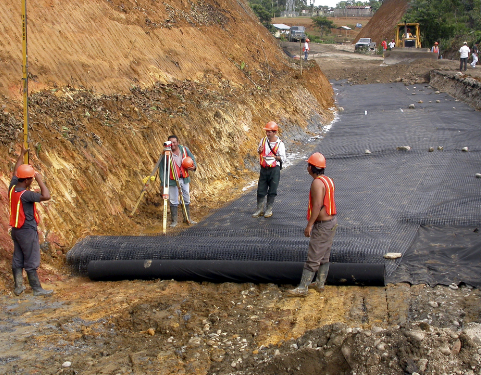- Understanding the Role of Geomembrane Liners in Waste Management
- Innovations in Geomembrane Liners for Water Management
- Geomembrane Liners: A Comprehensive Guide
- The Future of Geomembrane Liners in Civil Engineering
- Geomembrane Liners: Enhancing Landfill Stability
Manager:
WhatsApp:+86 177 0135 2670
Tel:+86 177 0135 2670
Email:marketing@okorder.com
Address:3rd Floor, No.2 Building, No.1 Sanlihe Road
What is the impact factor of geotextile and geomembrane?
Geotextiles and geomembranes are indispensable materials in modern civil engineering and environmental protection projects. They serve a multitude of functions, ranging from soil stabilization to waste containment. Understanding the impact factors of these materials, particularly composite geomembranes and high-density polyethylene (HDPE) geomembranes, is crucial for ensuring the success and longevity of various applications.

Introduction to Geotextile and Geomembrane
Geotextiles are permeable fabrics made from synthetic or natural fibers, designed to improve soil stability, filtration, drainage, and erosion control. On the other hand, geomembranes are impermeable sheets or liners used for containment applications such as landfill liners, pond liners, and canal liners. Both geotextiles and geomembranes play pivotal roles in civil engineering, environmental protection, and geotechnical applications.
Composite Geomembrane: An Overview
Composite geomembranes combine the advantages of multiple materials to achieve superior performance in containment applications. Typically, a composite geomembrane consists of two or more layers, including a geomembrane layer for impermeability and a geotextile layer for protection, reinforcement, and filtration.
The incorporation of geotextile into composite geomembranes enhances their puncture resistance, tear resistance, and interface friction properties. These improvements make composite geomembranes particularly suitable for applications where robust containment and environmental protection are essential.
Impact Factor of Composite Geomembranes
1. Mechanical Properties: The mechanical properties of composite geomembranes, such as tensile strength, puncture resistance, and tear resistance, significantly impact their performance in containment applications. The presence of a geotextile layer enhances these properties, providing added strength and durability to withstand external forces and environmental stresses.
2. Hydraulic Performance: Composite geomembranes play a critical role in controlling fluid migration and seepage in containment systems. The interaction between the geomembrane and geotextile layers influences hydraulic conductivity, filtration efficiency, and resistance to clogging. By optimizing these factors, composite geomembranes ensure effective containment and environmental protection.
3. Long-Term Durability: The long-term durability of composite geomembranes is essential for the sustainability of containment structures. Factors such as UV resistance, chemical resistance, and dimensional stability affect the service life of geomembrane liners. The inclusion of geotextile layers can mitigate degradation mechanisms and prolong the lifespan of composite geomembranes in harsh environmental conditions.
4. Interface Friction and Compatibility: The interface friction between geomembranes and adjacent materials, such as soil or geosynthetic clay liners, influences stability and integrity. Geotextile layers in composite geomembranes provide a textured surface that enhances interface friction, reducing the risk of slippage and ensuring proper containment system performance. Additionally, compatibility between geomembranes and surrounding materials is crucial to prevent leakage and ensure effective containment.
High-Density Polyethylene Geomembrane: Characteristics and Applications
hdpe Geomembranes are among the most widely used geomembrane materials due to their excellent chemical resistance, durability, and flexibility. Manufactured through a high-pressure process, HDPE geomembranes exhibit superior tensile strength, tear resistance, and environmental stress crack resistance compared to other geomembrane materials.
Impact Factor of HDPE Geomembranes
1. Chemical Resistance: The chemical resistance of HDPE geomembranes is a key factor in their performance in containment applications involving aggressive substances such as chemicals, acids, and hazardous waste. HDPE's inert nature ensures compatibility with a wide range of chemical environments, minimizing the risk of degradation and leakage.
2. Flexibility and Conformability: HDPE geomembranes offer excellent flexibility and conformability to irregular subgrades, ensuring seamless installation and optimal containment system performance. Their ability to accommodate ground settlement and deformation without compromising integrity is crucial for long-term stability and effectiveness.
3. Seam Strength and Integrity: The strength and integrity of seams are critical aspects of HDPE geomembrane installations, as they determine the overall reliability of containment systems. Proper welding techniques and seam quality assurance measures are essential to achieving robust and leak-proof seams, thereby preventing fluid migration and environmental contamination.
4. Environmental Stress Crack Resistance: Environmental stress crack resistance (ESCR) is a measure of HDPE geomembranes' ability to withstand cracking when exposed to environmental factors such as UV radiation, temperature fluctuations, and chemical exposure. High ESCR ensures long-term durability and performance in outdoor applications, minimizing the risk of premature failure.

Conclusion
In conclusion, the impact factors of geotextile and geomembrane materials, including composite geomembranes and HDPE geomembranes, play a crucial role in the success and longevity of containment applications. By understanding and optimizing factors such as mechanical properties, hydraulic performance, durability, and compatibility, engineers and environmental professionals can design and implement effective containment systems that ensure environmental protection and regulatory compliance. Whether in landfill construction, mining operations, or wastewater treatment facilities, the choice of geomembrane materials and their impact on containment performance are paramount to achieving sustainable and resilient infrastructure."
- Previous:How thick is a geomembrane?
- Next:Which is stronger HDPE or Uhmw?
-
2024-06-13Geomembrane is not plastic cloth






